Black Diamond General Contractors talks about the scope of work on a large new multi-family home development project in South Carolina and how its fleet of CASE equipment power them from the first work on the job to when they hand it over at completion. All with the help of Hills Machinery.
• Image Courtesy of CASE Construction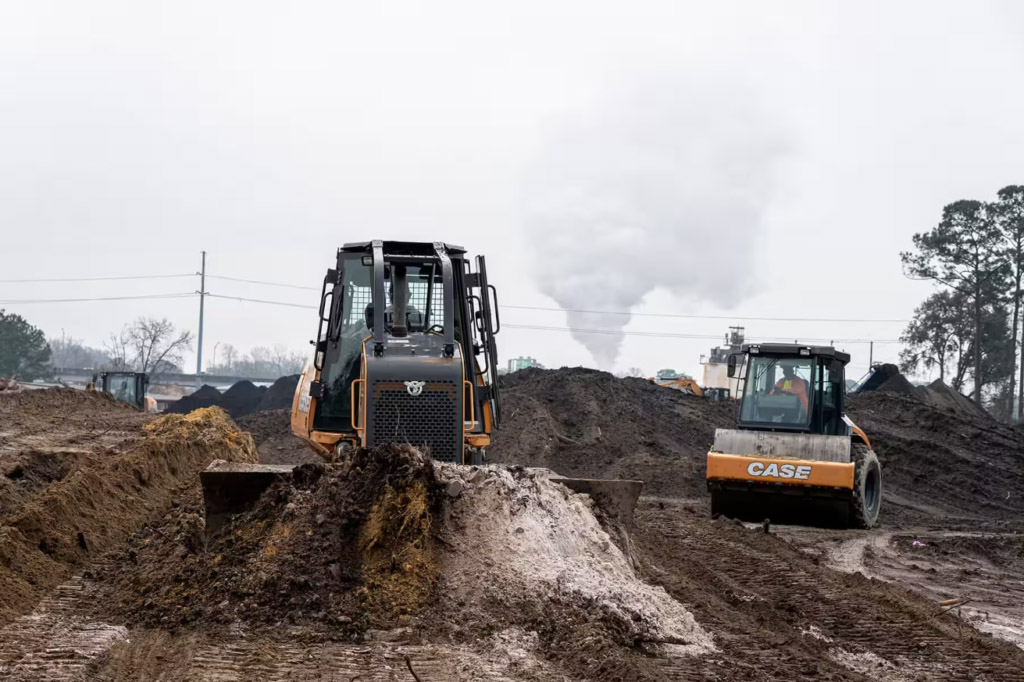
Founded in 2017 by father-and-son team Robert Timberman and Robert Timberman Jr., Black Diamond General Contractors is a full-service earth work and site work company based in the Charleston Peninsula of South Carolina. They do a bit of everything — from groundwork, infrastructure work, water, sewer city work, city repairs — they even have a vertical construction division.
“We do a lot of public utilities, site development, and we do some vertical construction, mostly in residential. We do commercial as well. Essentially, what we are is a one-stop shop. We’ll get a site that’s completely wooded. We’ll clear it, develop it, install the stormwater, water mains, sewer mains, and the public utilities and hand over a finished product ready for vertical construction.”
says Robert Jr.
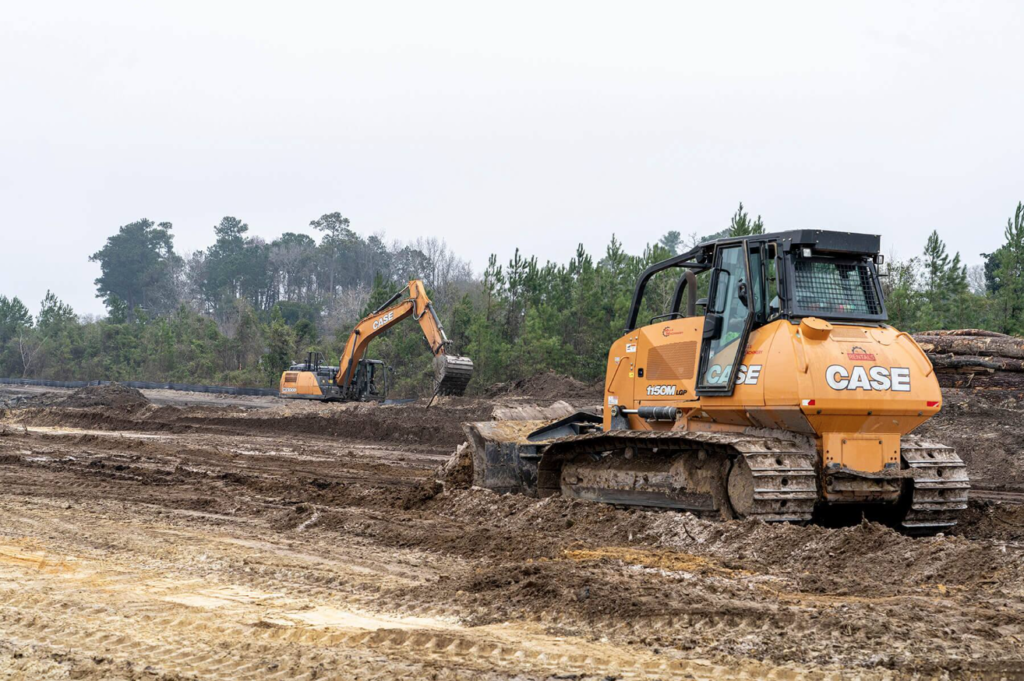
The Timbermans explain that one of the keys to success when developing a site from the ground up, is the ability to use as many on-site resources as possible.
“The thing we’re probably most known for is the ability to go onto a site and use every resource of the site. From the topsoil screening, the roots of the trees, recycling for mulch and those type of things that are created along the way…”
Robert Sr. says.
Black Diamond is currently working on a 26-acre site that will be the location of more than 300 multi-family housing units. The lot, once their crews began initial clearing efforts, turned out to have an interesting history.
“When we moved on to it, it was wooded. It dated all the way back to the Civil War. And it was used, at that point in time as a sand mine, and also a lumber mill for railroad ties. That continued all the way through the 1950s. And that’s why you see the settling ponds and some of the other areas in the background which we are filling.”
Robert Sr. explains.
“When we got the site, we found a couple pieces of railroad iron from the early 1900s. This site was heavily timbered, and we had a lot of low areas that were holding water, not necessarily wetlands but just holding a lot of water with a clay bottom. So, a lot of our tracked equipment was having trouble getting through that. But the low ground pressure machines from CASE really did the job in getting through there and getting us to where we can get to hard ground.”
Robert Jr. adds.
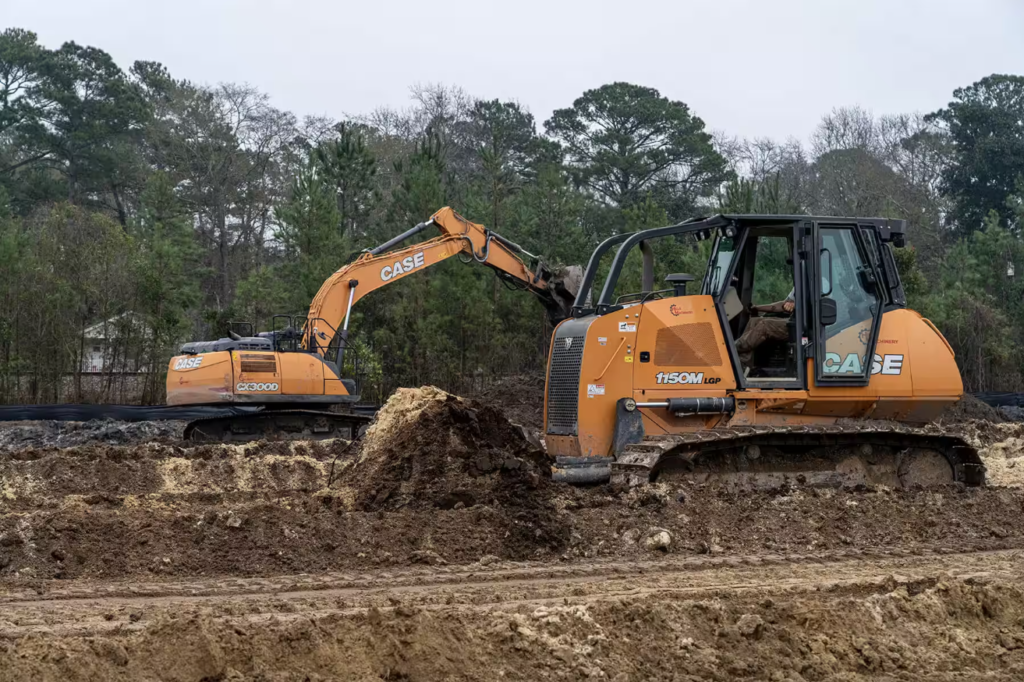
A Growing Fleet
The Timbermans started Black Diamond with a single compact track loader — a CASE TR340. Now, Black Diamond owns 17 CASE machines, and many of them are currently working on this 26-acre site.
“We’ve got a 650M dozer, two 1150M dozers, one that has a Leica [machine control] system installed. We’ve got an SV212D roller. We’ve got a 921F wheel loader, a CX145D excavator, a CX300D excavator, CX350D excavator, a CX210D excavator, a TR340 CTL and its multitude of attachments, all running currently at this time.”
Robert Jr. says.
Robert Sr. explains how the skid steer is one of the most critical machines on the site from the first day until it’s handed over. “The very first job is done by the skid steer, small clearings. And in the middle is usually the sweeper attachment, keeping the roadways clear. And then as we get to the end, the final dresses around the edges of the pads, sidewalks, curbs and all that, the skid steer is invaluable because of its lightweight and ability. Actually, it’s critical. Because of the implements that go on the TR340, it’s limitless, from the start of the silt fence that you see on the perimeter of the project. Without that auger and the trencher, there’s no way we could get everything put in place.”
“It’s an extremely versatile machine, and it’s also one of our first machines we ever bought from Hills Machinery. And here we are, seven years later, and I can’t even tell you how many hours it’s got on it, but we’ve abused that machine quite a bit and it’s held up. So, I’m very happy with it.”
Robert Jr. says
Black Diamond is also running a CASE SV212D single drum vibratory roller. This machine plays an important role in keeping jobsites operable during Charleston’s rainy season.
“The SV212D is probably one of the most important pieces on this jobsite, especially during the rainy season in South Carolina. What that machine allows us to do is to seal the top coat. So once the bulldozers go through and they cut open the ground, well now it’s soft. So, if it gets water on it you get soil infiltration. So, the roller, having it on site, it allows us to seal the top of the ground so that when the rain hits, the water just kind of sheds and doesn’t take any material with it. And it also allows us to stabilize that soil so that we can run other equipment in here without making it a muddy mess.”
Robert Jr. explains.
“Everyone always thinks of a roller in the terms of compacting the dirt. But the compactor also serves a secondary purpose, and that is it brings the water to the top. So, if we’ve had a week of rain or just like today it was a little bit of a rainy morning. To run that compactor, it will press that water to the top, compact the dirt underneath it and the wind and air will dry it out, which puts the job site back in action faster.”
Robert Sr. adds.
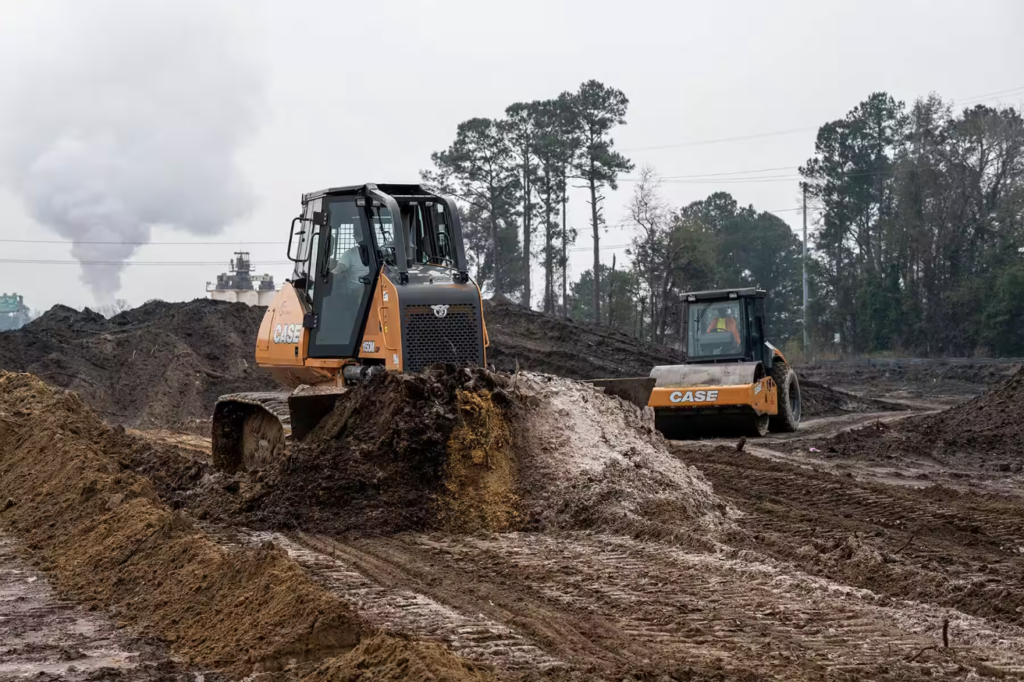
Excavators Handle All Phases of Site Development
Some of the busiest machines on the site are four CASE excavators — a CX145D minimum swing, CX210D, CX300D and CX350D. The Timbermans appreciate the powerful, versatile and feature-rich machines.
“There are 16 retention ponds total on the project. That back dig has 81,000 cubic yards being removed from it. The CX350D is just invaluable when it comes to moving that amount of material.”
Robert Sr. says.
With the amount of grading necessary on an undeveloped site, at least one of the excavators is feeding a portable plant all day — separating roots, old bricks and other materials in order to produce usable topsoil that can be used onsite or sold locally. They also put the larger excavators to work when clearing timber. Robert Sr. stands near a mountain of 60+ foot pine logs, having just finished a conversation with a local timber broker.
“On this project, there were some very, very large trees, so that’s why all our excavators always get a thumb. When we’re trying to take down some of these larger trees, [the CX350D] is about the only machine that’s going to handle those stumps. When we get our equipment, all of our equipment right down to Bluetooth, stereo systems, the cabs, the AC, everything. If your operator is comfortable, they’re going to complete their job much easier than if they’re stressed — like any other profession. If you were sitting at a desk, you would have the most ergonomic chair that’s possible. Well, if you’re sitting in a piece of equipment, contrary to what people may believe, it is pure work. And you want to make them as comfortable as possible.”
CASE D Series excavators come standard with a wealth of standard features.
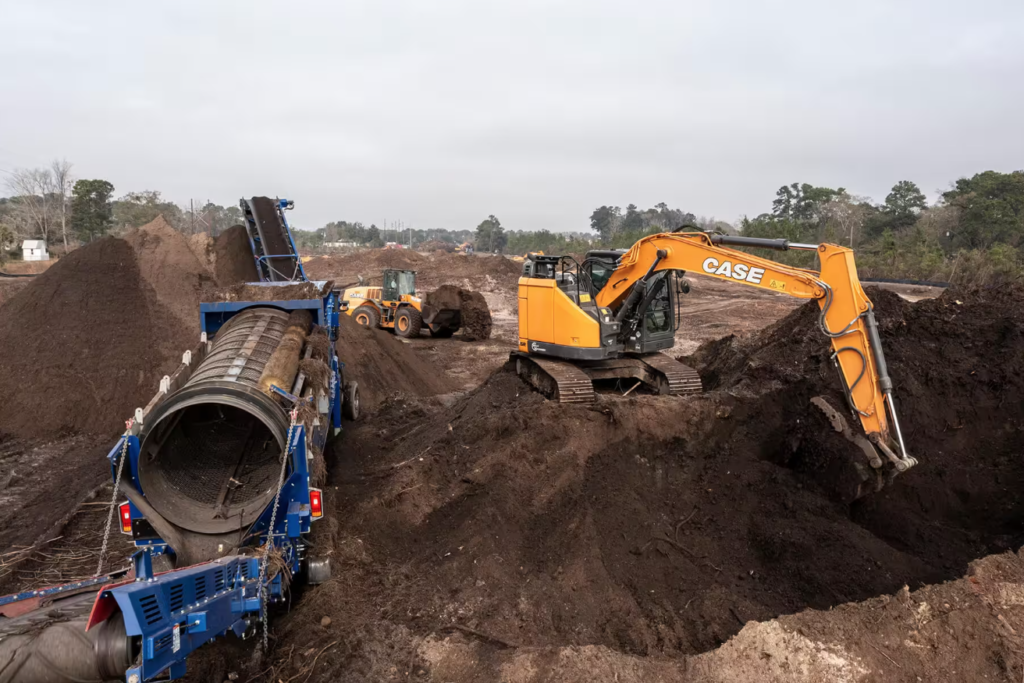
Dozers Shape the Site from Site Prep to Final Grade
At this point in the project, the dozers on site have graded down 5 feet, with an additional 2 feet to go. Robert Jr. explains the process.
“We’ll start with the 650M — it’s equipped with a root rake. So, in the initial ground clearing stage, that root rake is instrumental for clearing a lot of the organics out of the top of the soils and stuff like that and helping us clear the sites. It’s absolutely a workhorse and has plenty of power. It’s also a rough grade [dozer]. Once we remove the root rake, we’ll use it to cut a lot of the overburden and top soil out of our way to get down to the strata that we want.”
After the rough grade, Black Diamond runs two CASE 1150M dozers in tandem — one of which is equipped with a Leica machine control solution.
“I cannot speak enough to the power. They sound like jet engines when they get going. And running them in tandem is just a really great way to push a lot of dirt in a very short amount of time. Two of our experienced operators will actually run the blades touching, and then run down the line and push. Like I said, they cut five feet off of this particular area in a day — that’s an extreme amount of dirt to move. Then the 1150M with the Leica system is definitely our finished grade dozer. And the automatic mode, we have it set within five-tenths of where we want to be, and then it’ll absorb or engage the automatic mode. Once you’ve prepped and then you engage the automatic mode, it will do different pitches if you have crowns in your road, inverted crowns. It really is an all-around, versatile machine. I absolutely love our CASE equipment. I’ve had a lot of different pieces of equipment over the years. My dad’s been building for 37 years and I’ve been building under him most of my life. The overall ease of use, ease of maintenance, ease of repair — it is by far one of the easiest pieces I’ve been able to work on.”
Robert Jr. says.
“The machine control options are invaluable. The Leica system, we’re just starting out with it. While everything’s speaking to one another. If my man is placed in a box for storm and using the Leica, the dozer knows exactly where it’s at, we’re using the exact same coordinates, the exact same system.”
Robert Sr. adds.

Protected by CASE ProCare
Black Diamond buys all of their CASE equipment through Hills Machinery. All CASE D Series excavators and M Series dozers come standard with CASE ProCare – a three-year CASE SiteWatch™ telematics subscription, a three-year/3,000-hour full-machine factory warranty, and a three-year/2,000-hour planned maintenance contract.
“It’s invaluable. We’re equipment operators. We know how to do job sites. We know how to run that. Equipment has evolved to the point to where all of the new systems that are incorporated in it, which are a huge benefit, also create a huge challenge. So, to have somebody trained, that’s available at any given time, and Hills Machinery will answer the phone, whether it’s Sunday, it does not matter, there is always someone available to me in order to take care of that system and get it up and running or adjusted if need be. I can call them on the phone, they can walk me through the codes, if I want to adjust the pressure on the thumb, he’ll tell me exactly how to walk through the screen and do that.”
Robert Sr. explains.
“They help keep track of your maintenance. They keep you accountable for it which, honestly, when you’re out here doing this kind of work, it slips your mind. You don’t really think about doing your maintenance until you hear something squeaking or breaking. You hate to say it that way, but that’s the reality of our industry. We do a really good job of staying on top of it, but the ProCare package is absolutely instrumental. And I think the argument was always, ‘is it worth the money?’ And the answer is yes, especially with a company like Hills, because they definitely hold up their end of the bargain on that kind of thing.”
Robert Jr. adds.
Your CASE Dealer as a Strategic Partner
“If it wasn’t for Hills Machinery and CASE we would not have a business, point blank. We started in 2017 with this particular venture. We started with the TV340 skid steer and then eventually got an excavator and then grew into a 650M Dozer. After that, as the larger jobs formed, I sat with Mr. Hills and also our salesman Donnie Buhrmaster, and we formulated that growth and we were very strategic in what pieces to buy, when to buy them and how that would fit into my overall plan. So, Hills was beyond instrumental in helping us in this growth, otherwise it would not have been possible. Knowing the right piece of equipment at the right time is probably our weakest component for myself and my son. To jump into this level of grading and work that we do and the amount of it at this point in time, that advice, that guidance was invaluable.”
Robert Sr. says.
With a lifetime of experience, and the help of a good partner in Hills Machinery, the Timbermans were able to take an idea and turn it into a large, profitable venture in a short period of time. Robert Sr. offers some advice to other equipment owners on how to get the most out of your equipment investments.
“The equipment is going to cost you to sit there. Whether it’s being run or whether it’s not, your payment is coming due. So, any advice I would give to everyone is run your equipment as much as you can. Your hours are always going to be your hours. Your overtime pay versus your equipment costs and your production levels… The more production you get out of your equipment monthly, you are far better off than trying to conserve on the pay. The men, I leave it as an option, they can work 40 hours a week, or they can work all the overtime that they wish. It’s worked for us. We’ve managed to pull off projects that would normally be 12 months, and we’re entering our sixth month, and getting ready to pave and leave the job. We have trimmed six months off of that schedule by adopting the overtime, running the equipment, which allowed us to grow and get more equipment because that project was done, and it gave us the ability to go on to the next opportunity.”
Source: CASE Construction
 Copyright 2020 All rights reserved.
Copyright 2020 All rights reserved.